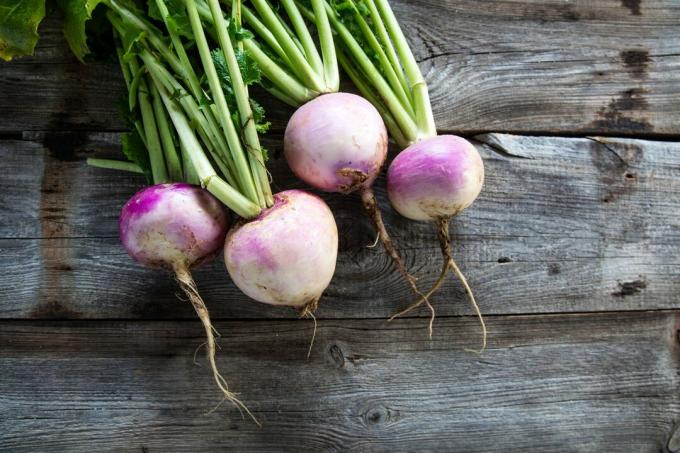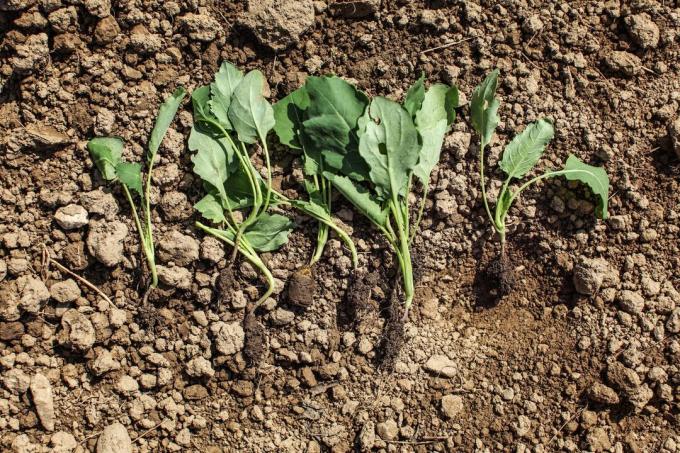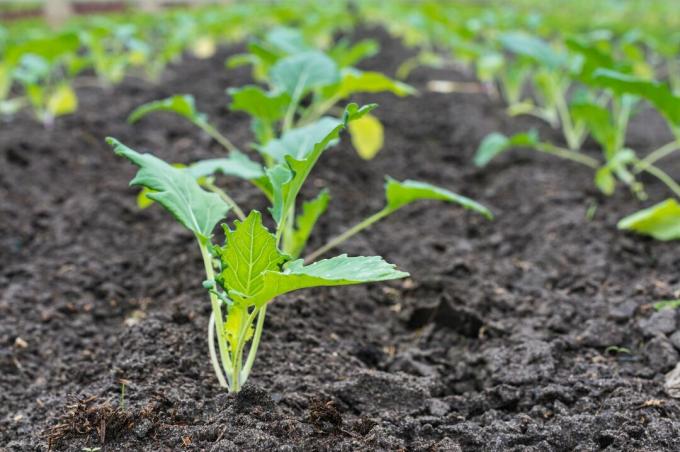Depending on the time of sowing, the turnip can turn into autumn turnip. We show what you have to consider when growing, caring for and harvesting maize and autumn beet.

May beets (Brassica rapa subsp. rapa var. majalis) and turnips (Brassica rapa subsp. rapa subvar.esculenta) are very similar in cultivation. Only their planting and harvest times differ from each other. Growing turnips in your own garden is always worthwhile: They are easy to care for, grow quickly and are full of vitamins and minerals. We'll tell you everything you need to know about the origin, the right choice of variety, the cultivation, care and harvest of May and autumn beets.
contents
- May beet: origin and characteristics
- May beet and autumn beet varieties
- Buying beetroot: You should pay attention to that
- Grow turnip and turnip
- Maintain May beets
- Harvest and store May beets
- May beets: use and ingredients
The different botanical names of corn and autumn turnips show that the two are not one and the same plant. In fact, both are special forms of turnip (Brassica rapa subsp. rapa). The two names indicate when the beets are harvested: May turnips are grown in spring and harvested in May - autumn beets, on the other hand, only later in the year. Both belong to the cruciferous family (Brassicaceae). Both look similar to radish (Raphanus sativus var. Sativus), but are a bit larger.
Both May and autumn beets have an incredible variety of varieties and differ mainly in their shape and color. There is an old custom in Switzerland that is reminiscent of Halloween pumpkins. Instead of pumpkin (Cucurbita) Autumn turnips are hollowed out and carved there. The so-called "Räbenlichter" then illuminate dark autumn nights. In Austria, a schnapps is even made from autumn beets, the so-called Krautinger. The turnips have been popular for centuries because they are easy to care for and are not sensitive to frost.

May beet: origin and characteristics
May turnips and autumn turnips were grown in ancient times. Before the introduction of the potato (Solanumtuberosum), they played an important role as the staple food of the people in Europe. But once the potato was on the menu, the beets were almost completely pushed off the plates. In the post-war period they were then increasingly grown again, both as root crops and as fodder crops. After the hardship, however, many did not want to be reminded of the barren post-war years, so that May and autumn turnips were spurned and rarely landed on the plate. It is only in the last few years that beets have regained importance as a regional and seasonal vegetable.
May and autumn turnips are biennial plants. In the first year they form a tuber in the ground and a rosette of leaves above ground. The beets are almost always grown only as an annual. If you cultivate them in the second year, autumn and May beets form a branched inflorescence with yellow flowers. The edible beets are, strictly speaking, the thickened, lowest part of the stem axis - the hypocotyl - and the uppermost part of the root. Depending on the variety, May and autumn beets produce white, purple, red or yellow beets with white or yellow pulp.
May beet and autumn beet varieties
The individual varieties of May and autumn beet differ primarily in the shape and color of the beet. We are introducing you to some of the tried and tested varieties of the two beets.
May beet varieties
- Munich turnipˈ: This variety is characterized by a flat, round shape and a delicately red head. It does not form too lush foliage.
- "Snowball": The beets of this variety really look like snowballs: they are round and completely white.
- "Milanese": The beets of this variety are rather flat and have a red head.
- "Primera": This variety of May turnips has a particularly delicate taste that is reminiscent of kohlrabi. The turnips are red-headed and flat.

Autumn beet varieties
- ˈBortfelderˈ: This beet variety forms elongated, yellow-fleshed beets. It can be stored very well.
- ˈGold Ballˈ: As the name suggests, this variety is round and yellow-fleshed. It is also characterized by a particularly short growth time of just two months.
- "Ulmer ox horn": This variety makes elongated, slightly curved turnips with a white-purple color.
- "Zurich": This variety convinces with a round turnip and a purple head. It can be stored very well.
Buying beetroot: You should pay attention to that
May turnips and autumn turnips can easily be brought forward yourself or, even better, sown directly in the bed. Therefore, the purchase of young plants that have already been grown is not recommended. When buying May or turnip seeds, you should pay attention to the right variety. Depending on whether you want to grow the beets in spring or autumn, you have to choose different varieties. Should you nevertheless decide to buy early grown young plants, make sure that the plants are in a healthy and vital condition. You can buy seeds and young plants for May and autumn beets in hardware stores, garden centers, nurseries or on the Internet.

Grow turnip and turnip
The cultivation of maize and autumn beets differs mainly in terms of the time of cultivation. There are no major differences in care and harvest. In the following section we will tell you what to look out for when growing the two beets.
Growing turnip and turnip: the perfect location
Both May and autumn beets are poor eaters and do not place particularly high demands on their location. In a sunny to partially shaded spot with light, humus rich soil, the turnips are quite satisfied. The beets are less happy with waterlogging, as this is where they start to mold and rot. Soils that are too acidic are also unfavorable - the optimal pH value should be above 6.5.
Summary of location requirements for May beet and autumn beet:
- Sunny to partially shaded location
- Light, humus soil
- pH above 6.5
- No waterlogging
Tip: As with all plants that belong to the cruciferous family, a cultivation break of three years should be observed after beet cultivation, otherwise diseases such as Carbonic hernia Can move in.

Sow and grow May beets
May turnips can also be brought forward, but they also work very well with direct sowing in the garden bed and the time from sowing to harvest is very short. If you prefer to bring your May turns out, you can start doing so as early as February on the warm windowsill or in the heated greenhouse. At temperatures above 5 ° C, May turnips begin to germinate, the optimal germination temperature is between 15 and 18 ° C. You can start sowing directly in the garden bed from March.
Prepare the bed for sowing outdoors by loosening the soil well, removing weeds and, if necessary, incorporating compost. Alternatively, you can also work an organic slow release fertilizer into the soil to improve the soil structure and enrich the soil with nutrients. We recommend our Plantura organic universal fertilizer with organic long-term effect.
The May turnips are sown two centimeters deep, with a row spacing of 20 to 25 centimeters. The distance between the plants should be 10 to 15 centimeters. Alternatively, you can broadly sow the May turnips and then separate them later as soon as they are in the dicotyledon stage. Then the seed is poured on and kept moist. Your May turnips should germinate after seven to twelve days.
Summary of sowing and growing May beets:
- Move forward from February
- Sow in the garden bed from March
- Loosen the seedbed, remove weeds, if necessary compost or incorporate organic long-term fertilizer
- Optimal germination temperature: 15 - 18 ° C
- Seed depth: 2 cm
- Plant spacing: 10 - 15 cm
- Row spacing: 20 - 25 cm
- Germination after 7-12 days

Tip: Good neighbors for the turnip are Strawberries (Fragaria) or Carrots (Daucus carota subsp. sativus). Rather unsuitable Cucumber (Cucumis sativus) and zucchini (Cucurbita pepo subsp. pepo convar. giromontiina).
Sow and grow autumn beets
Autumn turnips are sown and grown in a similar way to May turnips. Only the time of sowing is different: Autumn beets are sown at the beginning of August. Here, too, it is not necessary to bring the young plants forward. The sowing depth for autumn beets is also two centimeters. The row spacing of autumn turnips should be slightly larger than that of May turnips: 20 to 25 centimeters should be sufficient. The distance between the plants is also somewhat larger; it is 20 to 30 centimeters.
Summary growing autumn beets:
- Sow in the bed from the beginning of August
- Seed depth: 2 cm
- Plant spacing: 20 - 30 cm
- Distance between rows: 20-25 cm
Both May and autumn beets can withstand frosts down to -10 ° C.
Tip: Good neighbors for autumn beets are endive (Cichorium endivia) or Lamb's lettuce (Valerianella locusta).
Maintain May beets
May and autumn beets are very frugal to grow and require little care. You should just make sure that the plants do not dry out and therefore water them regularly when it is dry. In addition, regular hoeing ensures that weeds cannot spread and that the soil is nicely loosened. A finely crumbly surface of the soil is particularly important for beets. It promotes even growth and good development of the beets. Since May and autumn beets are poor consumers, additional fertilization is not necessary. It is enough if you use the soil when planting compost or organic slow release fertilizer, such as our Plantura Organic universal fertilizer, have enriched.
Harvest and store May beets
Harvesting can take place six to eight weeks after sowing. When harvested, the beets should have a maximum diameter of ten centimeters. Because the smaller they are, the more delicate and delicate their taste. For harvesting, the beets are carefully pulled out of the earth by the leaves. If the beets are to be stored, the heart leaves must remain on the beet. If you want to eat the beets straight away, the leaves are turned off. Fresh turnips can be stored in the refrigerator for a good four weeks. For larger quantities of turnips, storage in the basement or in underground heaps is ideal. This is particularly interesting for autumn beets that are to be stored over the winter. But May turns can also be stored in this way. In the cellar, the beets can be stored in a box with slightly damp sand. In the basement or in the ground rent, autumn beets will last until next spring and provide you with fresh vitamins throughout the winter.

May beets: use and ingredients
May turnips contain carbohydrates, protein, calcium, potassium, phosphorus, iron, sodium, provitamin A, as well as vitamins B1, B2, B6 and C - a real vitamin bomb. In terms of taste, the beets can be used with, depending on the variety Kohlrabi or mild radishes and have a strong, spicy aroma. You can use the beets fresh as raw vegetables or in salads. The beets can also be stewed, stewed or made into stews.
If you haven't had enough of beets, you'll find everything here Growing and caring for turnips.
